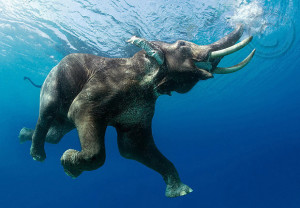The elephant, the planet’s largest terrestrial mammal, is a fascinating creature but it remains an unfortunate target of the poaching underworld. It is believed that years ago there were more than 300 species of Elephant, however today there only remains two: the Asian and African species. The African Elephant is the largest, with huge ears and unisex tusks. The Asian Elephant has a large body too, but with smaller ears! The females also do not develop tusks for this species.
1. Elephants know every member of their herd and are able to recognize up to 30 companions by sight or smell.
2. The word “elephant” comes from the Greek word “elephas” which means “ivory”.
3. The elephant’s gestation period is 22 months – longer than any other land animal in the world. A newborn human baby weighs an average of 7 pounds while a newborn elephant baby can weigh up to 260 pounds! The baby can stand up shortly after being born.
4. An elephant’s memory is not limited to its herd, nor is it limited to its species. In one instance, two circus elephants that performed together rejoiced when crossing paths 23 years later. Elephants have also recognized humans that they once bonded with after decades apart.
5. The oldest known elephant in the world lived for 86 years (1917 – 2003). The average lifespan of an elephant is from 50 to 70 years. The largest known elephant was shot in Angola in 1956 and weighed about 24 000 pounds! It had a shoulder height of 3.96 metres!
6. Don’t try to outsmart an elephant! They have an understanding of basic arithmetic and can even keep track of relative quantities.
7. The tusks of an elephant are modified incisors that grow throughout an elephant’s lifetime. An adult male’s tusks grow about 7 inches a year. Tusks are used to dig for salt, water and roots, to debark trees, to clear a path and occasionally in fights. Additionally, they are used for marking trees to establish an elephant’s territory.
8. Elephants are one of the few species who can recognize themselves in the mirror.
9. The elephant’s trunk is a fusion of its nose and upper lip. It is the elephant’s most important limb. The trunk is sensitive enough to pick up a blade of grass and strong enough to rip the branches off a tree. The trunk is also used for drinking – the elephant can suck up to 14 litres of water at a time and then blow it straight into its mouth!
When bathing, the elephant sucks water to spray on its body. It will then spray dirt and mud on its wet coat, which will dry and act as a sunscreen.
10. Elephants know every member of their herd and are able to recognize up to 30 companions by sight or smell.
11. The elephant’s very large ears are used to radiate excess heat away from the body.
12. Elephant behaviour is associated with a unique animal intelligence that displays grief, altruism, compassion, self-awareness, play, art and music!
13. The elephant brain is remarkably similar to the human brain, with as many neurons and synapses, as well as a highly developed hippocampus and cerebral cortex.
14. There is a structured social order in the elephant’s lifestyle. The females spend their entire lives in tight family groups made up of mothers, grandmothers, aunts, sisters and daughters. The eldest female normally leads the group. Adult males prefer to live a bachelor lifestyle.
15. Elephants are the only non-human animals to mourn their dead, performing burial rituals and returning to visit graves.
16. Don’t try to outsmart an elephant! They have an understanding of basic arithmetic and can even keep track of relative quantities.




